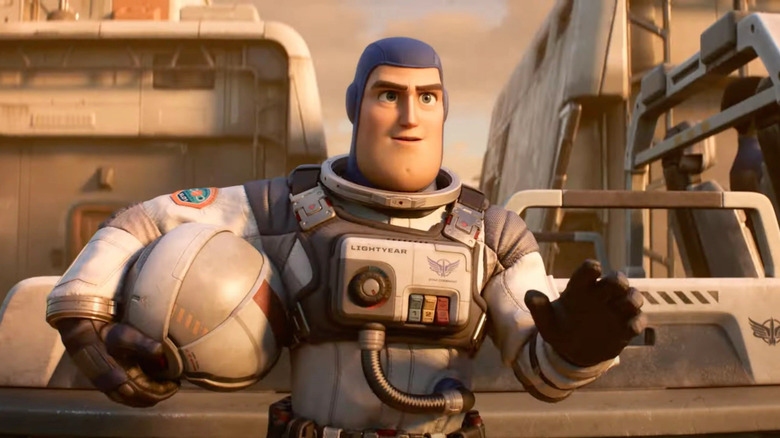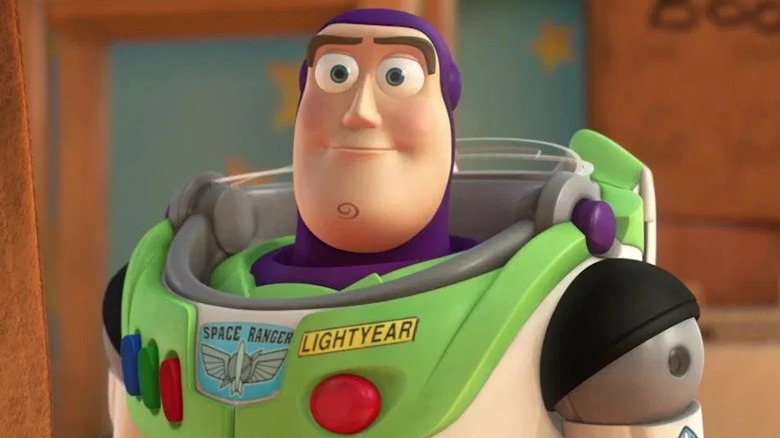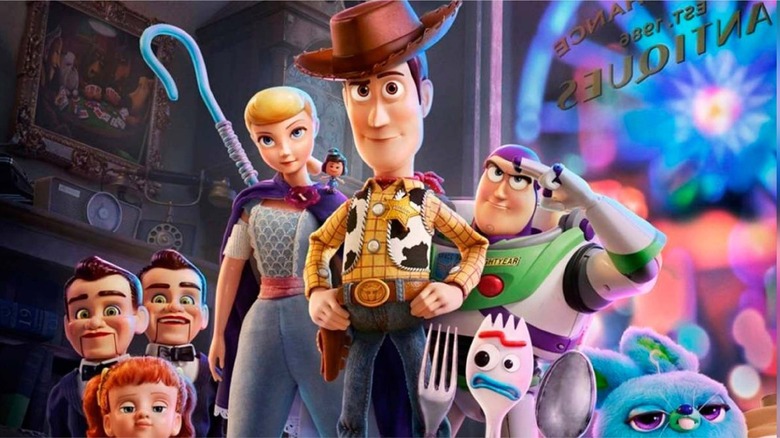How Buzz Lightyear Evolved From Pixar Short Character To Toy Story Hero
The film "Lightyear" tells the story of Buzz Lightyear, a space ranger in a film that is the inspiration for the toy Buzz in the "Toy Story" franchise from Disney/Pixar. It's a little complicated, but you get the idea. Buzz didn't just start as a character in the 1995 animated film though. His history is longer than that. Our space hero comes from a short story from John Lasseter called "Tin Toy" from 1988. You can watch it on Disney+ right now, but the animation of the character Billy is going to mess with your brain. You've been warned.
This five minute-short film happened in the early days of Pixar, when it wasn't the financial juggernaut it has become. Here's the story in case you haven't seen it: In "Tin Toy," a one-man band toy named Tinny who is bought for a toddler named Billy. That little guy is one of those kids who, when you give them a toy, they break it immediately. Tinny is understandably worried about his future, and discovers to his detriment, that playing his instruments attracts Billy's attention. He hides under the couch with other frightened toys, but comes out when he hears Billy crying. He plays for him so Billy feels better, and though Billy prefers the box Tinny came in (is Billy a cat?), it inspires the toys to want to help their new friend.
In the book "The Pixar Touch: The Making of a Company," by David A. Price, we learn that Tinny was connected with Buzz Lightyear, and that the story could have been very different.
To a gas station ... and beyond!
Originally the idea for "Toy Story" had a newly-manufactured Tinny going on a journey with a kid who leaves him at a gas station. He meets a ventriloquist's dummy who talks like a cowboy, and the two go on an adventure together. The thing is, according to Lasseter in the book, Tinny was sort of an old-fashioned toy, and wasn't likely to connect with kids.
(So wait, he thought that a tin one-man band was old-fashioned and wouldn't connect with children, but a ventriloquist's dummy would? What kind of children was he hanging out with? Old-timey demon children from a horror movie? Moving on.)
Lasseter said, " ... we started to analyze what a little boy would get these days that would make him so excited that he stopped playing with anything else." They changed Tinny into a sort of G.I. Joe-type character, which was Lasseter's favorite as a kid, but then he evolved to be a space ranger, "along the lines of Major Matt Mason, another 1960s toy." They called this character Lunar Larry, and then Tempus from Morph. Does anyone else feel like Pixar might have met its end if they hadn't changed this stuff?
So, Tempus was the name for a bit, but Woody was still a dummy who spoke like a cowboy. They named Woody after "Woody Strode, an African American character actor who appeared in John Ford and Sergio Leone westerns."
My restful sleep thanks you for changing those toys around
They first debuted in a short 30-second test from Lasseter in 1992. Here's is what Disney saw when Lasseter brought it to them:
The scene took place on top of a chest of drawers in the bedroom of Andy, their owner; Woody got Tempus out of the way as a rival for Andy's affections by tricking him into falling behind the chest, where he became stuck.
The idea was to show that there were a lot of things you could do in digital animation that you couldn't manage in hand-drawn animation, according to former Pixar employee Ralph Guggenheim. "So it took place in a room that was sort of dimly lit with 'blind shadows falling across the room, with a character [Woody] who had a plaid shirt on, which you could never do in hand-drawn animation.'"
Things weren't, according to the book, the way we came to know and love them, though. Woody, we learn, wasn't the super nice cowboy we're familiar with. Guggenheim said he was, "devious." He also said that Tempus from Morph, the eventual Buzz, was in a "lobster-red space suit," and that he was small and funny, and knew he was "a toy with an owner."
Disney executives didn't like Woody as a ventriloquist's dummy (since they were used in a lot of horror films and rightly so), so he was changed. Lasseter was inspired by a Casper the Friendly Ghost toy he had with a pull-string that let him talk. They changed Buzz's size and named him Buzz Lightyear after the astronaut Buzz Aldrin, and the rest is Pixar history.
"Lightyear" will hit theaters on June 17, 2022.


